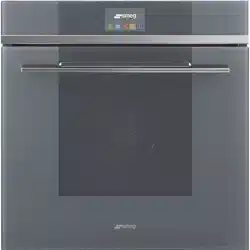Documents: Go to download!
User Manual
- User Manual - (English)
- Technical sheet - (English)
- Description
- Use
- Cleaning and maintenance
- What to do if...
- Installation
Table of contents
User Manual Smeg Oven
Description
General Description
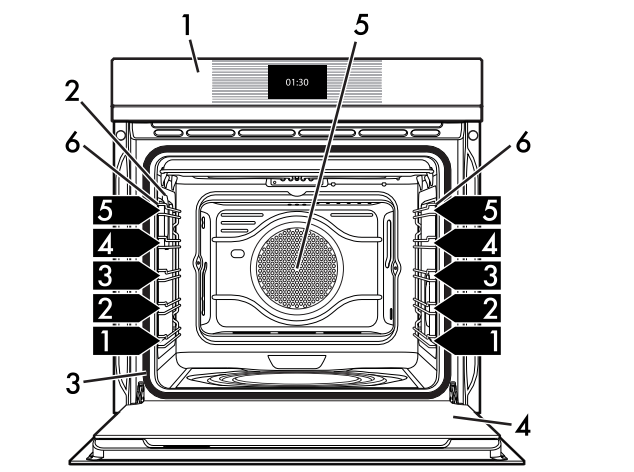
- Control panel
- Oven light
- Seal
- Door
- Fan
- Rack/tray support frames
 Frame shelf
Frame shelf
Control panel

- Display
- The touchscreen display allows you to interact with the appliance. Press the icons to access the various available functions. The display will show all operational parameters, such as: selected function, time/temperature settings or pre-set cooking program settings.
- In general, press the symbol
 to return to the previous menu or end a function; press the symbol
to return to the previous menu or end a function; press the symbol  to confirm the selected options.
to confirm the selected options.
Other parts
Shelves
The appliance features shelves for positioning trays and racks at different heights. The insertion heights are indicated from the bottom upwards (see General Description).
Cooling fan

The fan cools the oven and comes into operation during cooking. The fan causes a steady outflow of air from above the door which may continue for a brief period of time even after the appliance has been turned off.
Interior lighting
AThe appliance’s interior lighting comes on:
- When the door is opened.
- When any function is selected, apart from the
 and
and  functions.
functions. - Press the symbol
 to manually activate the oven light or the symbol
to manually activate the oven light or the symbol  to deactivate it during use.
to deactivate it during use.
Available accessories
Rack

Useful for collecting fat from foods placed on the rack above and for cooking pies, pizzas, and baked desserts.
Tray rack

To be placed over the top of the oven tray; for cooking foods which may drip
Rack

Used for supporting containers with food during cooking.
Oven tray

Useful for collecting fat from foods placed on the rack above.
Deep tray
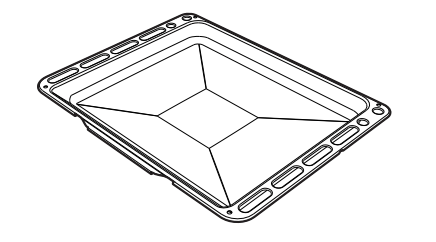
Useful for collecting fat from foods placed on the rack above and for cooking pies, pizzas, baked desserts, biscuits, etc.
The oven accessories intended to come into contact with food are made of materials that comply with the provisions of current legislation.
Supplied original and optional accessories can be requested to Authorised Assistance Centres. Use only original accessories supplied by the manufacturer.
Use
Instructions
High temperature inside the oven during use. Danger of burns
- Keep the oven door closed during cooking.
- Protect your hands by wearing heat-resistant gloves when moving food inside the oven.
- Do not touch the heating elements inside the oven.
- Do not pour water directly onto very hot trays.
- Do not allow children to get near the oven when it is in operation.
High temperature inside the oven during use. The danger of fire or explosion
- Do not spray any spray products near the oven.
- Do not use or leave flammable materials near the oven.
- Do not use plastic kitchenware or containers when cooking food.
- Do not put sealed tins or containers in the oven.
- Do not leave the oven unattended during cooking operations where fats or oils could be released.
- Remove all trays and racks which are not required during cooking.
Improper use. Risk of damage to enameled surfaces
- Do not cover the bottom of the oven cavity with aluminum or tin foil sheets.
- If you wish to use greaseproof paper, place it so that it will not interfere with the hot air circulation inside the oven.
- Do not place pans or trays directly on the bottom of the oven cavity.
- Do not pour water directly onto very hot trays.
First use
- Remove any protective film from the outside or inside of the appliance, including accessories.
- Remove any labels (apart from the technical data plate) from the accessories and from the oven cavity.
- Remove and wash all the appliance accessories (see 4 Cleaning and maintenance).
- Heat the empty oven at the maximum temperature to burn off any residues left by the manufacturing process.
Using the accessories
Racks and trays
Racks and trays have to be inserted into the side guides until they come to a complete stop.
- The mechanical safety locks that prevent the rack from being taken out accidentally have to face downwards and towards the oven back.
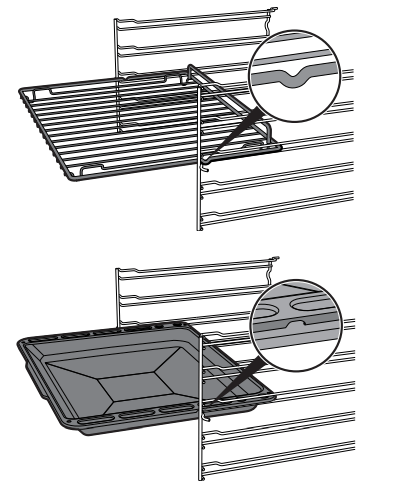
Gently insert racks and trays into the oven until they come to a stop.
Clean the trays before using them for the first time to remove any residues left by the manufacturing process.
Tray rack
The tray rack has to be inserted into the tray. In this way, fat can be collected separately from the food that is being cooked.

Using the oven
First use

On the first use, or after a power failure, will be flashing on the appliance's display. In order to be able to start any cooking program, the current time must be set (if the oven is being turned on for the first time, it is also recommended you set the required language). Touch the display to enter the settings menu.
On first use, the appliance language is set to “English” by default.
When first connecting or after the power has been cut for a time it will be necessary to wait a few seconds before you can interact with the appliance.
Home screen
Press the time on the display. It is now possible to select the various available functions on the home screen of the appliance.

- Settings
- Preset recipes
- Cooking functions
- Special functions
- Personal programs
symbol  , otherwise it will not be possible to turn on the oven. Press the key
, otherwise it will not be possible to turn on the oven. Press the key  to reset the programmer clock.
to reset the programmer clock.
Memory
Press the text  on the “home screen” to display the last preset recipes or personal recipes used (in the example, the recipe recipe 1 has been stored, see “Adding a recipe”).
on the “home screen” to display the last preset recipes or personal recipes used (in the example, the recipe recipe 1 has been stored, see “Adding a recipe”).

Deleting the memory
If you wish to delete the memory:
- Press the text
 on the “home screen” to display the last preset recipes or personal recipes used.
on the “home screen” to display the last preset recipes or personal recipes used. - Press the symbol
 .
.
- Select yes if you wish to delete the memory.

Cooking functions
- Select the cooking functions
 icon on the “home screen”.
icon on the “home screen”.
- Select the required function.

- The appliance will begin preheating. The display will show the chosen function, the pre-set temperature, the current time and the progress bar of the temperature reached (preheating).

- When the preheating stage is over a buzzer will sound to indicate that the food can be placed inside the oven.
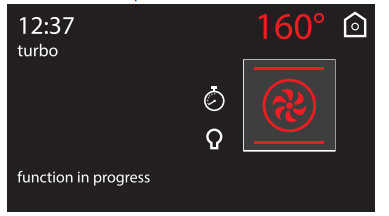
It is not recommended to place the dish in the oven during the automatic pre-heat stage.
Interrupting a function
Press the return symbol  for approximately 2 seconds to interrupt a cooking function. Select the required option.
for approximately 2 seconds to interrupt a cooking function. Select the required option.
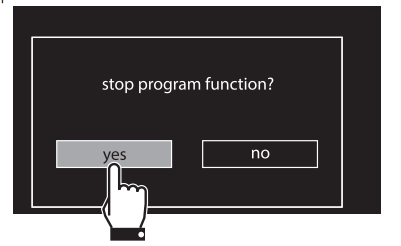
Changing a function during cooking
- Press the function symbol to modify it.
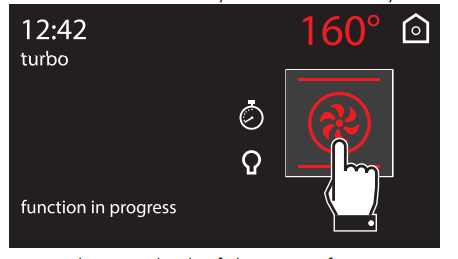
- Press the symbol of the new function required.
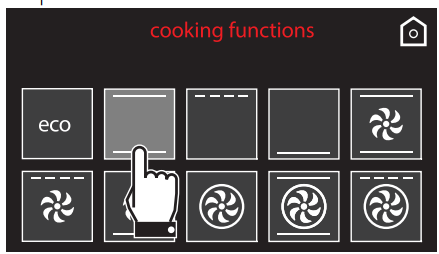
- The display will show the new function chosen, the preset temperature, the current time and the progress in reaching the new temperature.
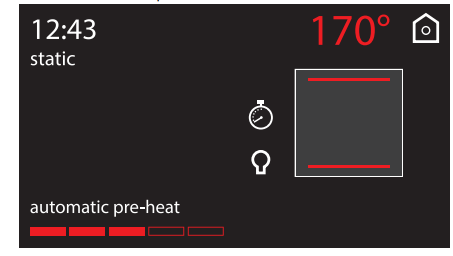
To avoid accidentally exiting the current function or screen displayed, the symbol must be pressed and held down for longer than usual. Pressing and holding the symbol for 3 seconds always exits the current screen and function.
must be pressed and held down for longer than usual. Pressing and holding the symbol for 3 seconds always exits the current screen and function.
Modifying the preset temperature
- Press the displayed temperature to change it.
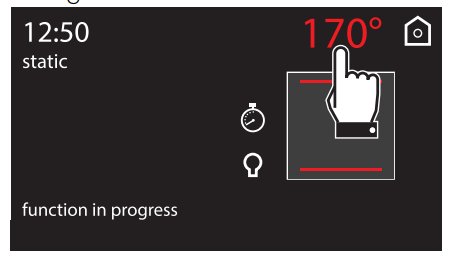
- Use the symbols
 and
and  to set the required temperature.
to set the required temperature.
- Press the symbol
 to confirm.
to confirm.
List of cooking functions
 ECO
ECO
This low energy consumption function is particularly suitable for cooking on a single shelf. Ideal when cooking meat, fish, and vegetables. It is not recommended for foods that require proof. For greater energy savings and to reduce the time required, it is recommended to put foods in the oven cavity without preheating them.
When using the ECO function, avoid opening the oven door during cooking.
When using the ECO function, cooking times (and pre-heating, if used) are longer.
 Static
Static
As the heat comes from above and below at the same time, this system is particularly suitable for certain types of food. Traditional cooking, also known as static cooking, is suitable for cooking just one dish at a time. Perfect for all types of roasts, bread and cakes, and in any case, particularly suitable for fatty meats such as goose and duck.
 Grill
Grill
The heat coming from the grill element gives perfect grilling results above all for thin and medium thickness meat and, in combination with the rotisserie (where fitted), gives the food an even browning at the end of cooking. Perfect for sausages, spare ribs and bacon. This function enables large quantities of food, particularly meat, to be grilled evenly.
 Lower element
Lower element
The heat coming just from the bottom allows you to complete the cooking of foods that require a higher bottom temperature, without affecting their browning. Perfect for cakes, pies, tarts and pizzas.
 Fan assisted
Fan assisted
The operation of the fan, combined with traditional cooking, ensures consistent cooking even with complex recipes. Perfect for biscuits and cakes, even when simultaneously cooked on several levels. (For multiple-level cooking, we recommend using the 2nd and 4th shelf).
 Fan with grill
Fan with grill
The air produced by the fan softens the strong heatwave generated by the grill, grilling perfectly even very thick foods. Perfect for large cuts of meat (e.g. shin of pork).
 Fan + lower element
Fan + lower element
The combination of the fan with just the lower heating element allows cooking to be completed more rapidly. This system is recommended for sterilising or for finishing off the cooking of foods which are already well-cooked on the surface, but not inside, which therefore need a little more heat. Perfect for any type of food.
 Circulaire
Circulaire
The combination of the fan and the circulaire heating element (incorporated in the rear of the oven) allows you to cook different foods on several levels, as long as they need the same temperatures and type of cooking. Hot air circulation ensures instant and even distribution of heat. It will be possible, for instance, to cook fish, vegetables and biscuits simultaneously (on different levels) without odours and flavours mingling.
 Turbo
Turbo
The combination of fan assisted cooking and traditional cooking allows different foods to be cooked on several levels extremely quickly and efficiently, without odours and flavours mingling. Perfect for large volumes that call for intense cooking. (For multiple-level cooking, we recommend using the 1st and 4th shelves).
 Circulaire + fan with grill
Circulaire + fan with grill
The combination of fan assisted cooking and traditional cooking allows you to cook different foods on several levels extremely quickly and efficiently, without odours and flavours mingling. Perfect for large volumes that call for intense cooking
Cooking advice
General advice
- Use a fan-assisted function to achieve consistent cooking at several levels.
- It is not possible to shorten cooking times by increasing the temperature (the food could be overcooked on the outside and undercooked on the inside).
- To prevent condensation from forming on the glass, hot food should not be left inside the oven for too long after cooking.
Advice for cooking meat
- Cooking times vary according to the thickness and quality of the food and to consumer taste.
- Use a meat thermometer when roasting meat, or simply press on the roast with a spoon. If it is hard, it is ready; If not, it needs another few minutes of cooking.
Advice for cooking with the Grill and the Fan with grill
- Meat can be grilled even when it is put into the cold oven or into the preheated oven if you wish to change the effect of the cooking.
- With the Fan grill function, we recommend that you preheat the oven before grilling.
- We recommend placing the food at the center of the rack.
Advice for cooking desserts/pastries and biscuits
- Use dark metal molds: They help to absorb the heat better.
- The temperature and the cooking time depend on the quality and consistency of the dough.
- To check whether the dessert is cooked right through: At the end of the cooking time, put a toothpick into the highest point of the dessert. If the dough does not stick to the toothpick, the dessert is cooked.
- If the dessert collapses when it comes out of the oven, on the next occasion reduce the set temperature by about 10°C, selecting a longer cooking time if necessary.
Advice for defrosting and proving
- Place frozen foods without their packaging in a lidless container on the first shelf of the oven.
- Avoid overlapping the food.
- To defrost meat, use the rack placed on the second level and a tray on the first level. In this way, the liquid from the defrosting food drains away from the food.
- The most delicate parts can be covered with aluminum foil.
- For successful proving, a container of water should be placed in the bottom of the oven.
To save energy
- Stop cooking a few minutes before the time normally used. Cooking will continue for the remaining minutes with the heat which has accumulated inside the oven.
- Reduce any opening of the door to a minimum to avoid heat dispersal.
- Keep the inside of the appliance clean at all times.
To save energy
- Stop cooking a few minutes before the time normally used. Cooking will continue for the remaining minutes with the heat which has accumulated inside the oven.
- Reduce any opening of the door to a minimum to avoid heat dispersal.
- Keep the inside of the appliance clean at all times.
- (Where fitted) When it is not being used, remove the pizza plate and put the cover back in its slot.
Special functions
The special functions menu contains some functions like the timer with the oven off, defrosting or cleaning functions. Select the special functions  icon on the “home screen”.
icon on the “home screen”.
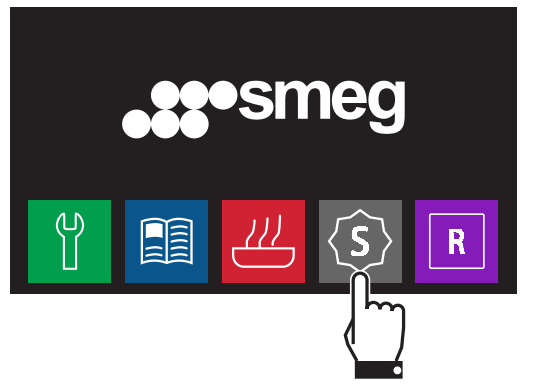
Certain functions are not available on all models.
List of special functions
 Timer
Timer
This function sounds a buzzer when the time set has elapsed.
 Defrost by weight
Defrost by weight
This function defrosts foods on the basis of the type and weight of the frozen product
 Defrost by time
Defrost by time
This function allows you to defrost food on the basis of a selectable time.
 Proving
Proving
The proving function, using the heat coming from the top, makes it possible to prove all types of dough, guaranteeing perfect results quickly.
 Food warming
Food warming
To heat food or keep it hot.
 Sabbath
Sabbath
This function allows food to be cooked while respecting the requirements of the Jewish Sabbath.
 Vapor Clean (on some models only)
Vapor Clean (on some models only)
This function facilitates cleaning using the steam produced by a small quantity of water poured onto the appropriate drawing placed on the bottom.
 ECO pyrolytic (on some models only)
ECO pyrolytic (on some models only)
When this function is set, the oven executes a pyrolytic cycle at 500°C for a pre-set time. For use in the case of ovens which are not too dirty
 Pyrolytic (on some models only)
Pyrolytic (on some models only)
Setting this function, the oven reaches temperatures up to 500°C, destroying all the grease which forms on the internal walls.
The more complex special functions are illustrated below. For functions such as Vapor Clean, Pyrolytic and ECO Pyrolytic, see “4 Cleaning and maintenance”.
Personal programs
This menu allows you to enter a personal program with the parameters you wish to use. On first use, the appliance will only offer to let you add a new recipe. After storing your recipes, these will then be available in the relative menu.
Select the personal programs  icon on the “home screen”.
icon on the “home screen”.
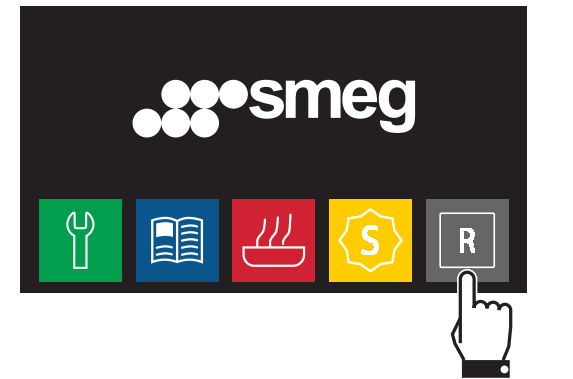
Up to 10 personal recipes can be stored.
Settings
The product is set using this menu.
Select the settings  icon on the “home screen”.
icon on the “home screen”.
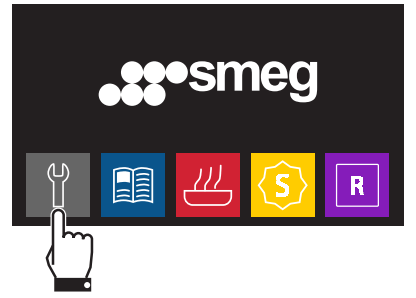
In the event of a temporary power cut, all personal settings will remain stored.
Language
Sets the interface language from those available.
- Select language from the “settings” menu.
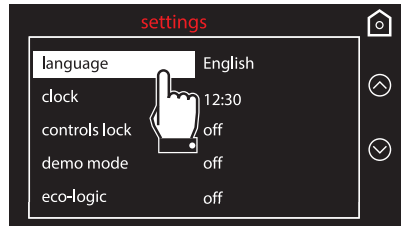
- Press the symbols
 and
and to select the required language.
to select the required language.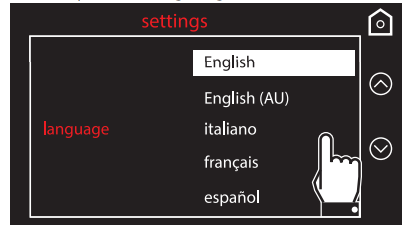
- Confirm the selected language.
Clock
- Press the symbol
 or
or and select clock from the “settings” menu.
and select clock from the “settings” menu.
- Enter the current time

- Press the symbol
 to confirm.
to confirm.
Control lock
- Press the symbol
 or
or and select controls lock from the “settings” menu.
and select controls lock from the “settings” menu.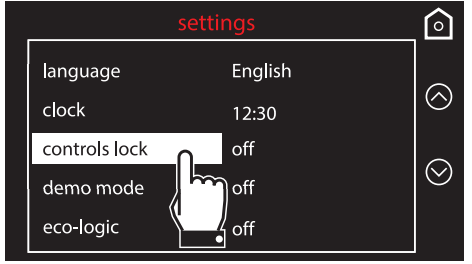
- To confirm activation of the controls lock, select yes.
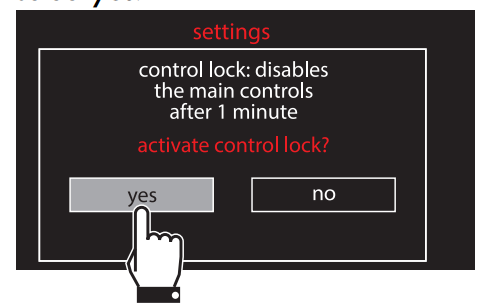
During normal operation it is indicated by the indicator light  coming on.
coming on.
Digital clock
- Press the symbol
 or
or and select digital clock from the “settings” menu.
and select digital clock from the “settings” menu.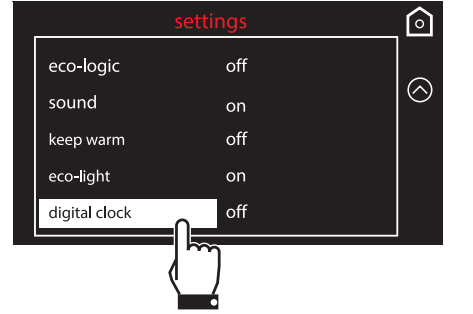
- To confirm activation of the digital clock, select yes.
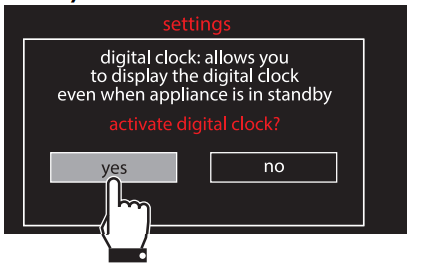
When no appliance function is active, the display will show the current time in digital format.

In the event of a temporary power cut, the digital version will remain selected.
Cleaning and maintenance
Instructions
Improper use
Risk of damage to surfaces
- Do not use steam jets to clean the appliance.
- Do not use cleaning products containing chlorine, ammonia, or bleach on steel parts or parts with metallic finishes on the surface (e.g. anodizing, nickel- or chromium-plating).
- Do not use abrasive or corrosive detergents on glass parts (e.g. powder products, stain removers, and metallic sponges).
- Do not use rough or abrasive materials or sharp metal scrapers.
Cleaning the appliance
We recommend the use of cleaning products distributed by the manufacturer.
Recommendations for cleaning the oven cavity
In order to keep your oven in the best possible condition, clean it regularly after letting it cool down. Avoid letting food residue dry inside the oven cavity, as this could damage the enamel.
Take out all removable parts before cleaning.
For easier cleaning, we recommend removing:
- The door;
- The rack/tray support frames;
- the seal (excluding pyrolytic models).
In the event you are using specific cleaning products, we recommend running the oven at maximum temperature for 15-20 minutes in order to eliminate any residue.
Removing the door
For easier cleaning it is recommended to remove the door and place it on a tea towel.
To remove the door proceed as follows:
- Open the door completely and insert two pins into the holes on the hinges indicated in the figure
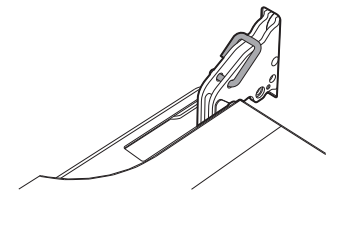
- Grasp the door on both sides with both hands, lift it forming an angle of around 30° and remove it.
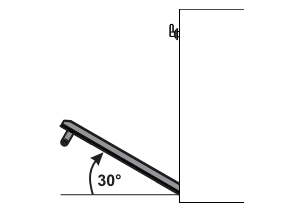
- To reassemble the door, put the hinges in the relevant slots in the oven, making sure that grooved sections A are resting completely in the slots. Lower the door and once it is in place remove the pins from the holes in the hinges.
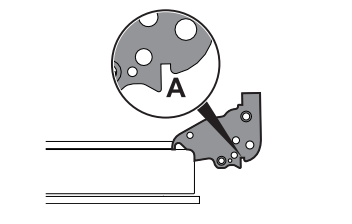
Cleaning the door glazing
The glass in the door should always be kept thoroughly clean. Use absorbent kitchen roll. In case of stubborn dirt, wash with a damp sponge and an ordinary detergent.
We recommend the use of cleaning products distributed by the manufacturer.
Removing the internal glass panels
For easier cleaning, the internal glass panels of the door can be removed.
- Remove the internal glass panel by pulling the rear part gently upwards, following the movement indicated by the arrows (1).
- Then, pull the front part upwards (2). In this way, the 4 pins attached to the glass are released from their seats in the oven door.

- Some models have an intermediate glass panel. Remove the intermediate glass panel by lifting it upwards.

- Clean the external glass panel and the panels were removed previously. Use absorbent kitchen roll. In case of stubborn dirt, wash with a damp sponge and a neutral detergent.

- Refit the panels in the reverse order in which they were removed.
- Reposition the internal glass panel. Take care to center and secure the 4 pins into their seats in the oven door by applying slight pressure.

Removing racks/trays support frames
Removing the rack/tray support frames enables the sides to be cleaned more easily. This operation should be performed each time the automatic cleaning cycle is used (on some models only).
To remove the rack/tray support frames:
- Pull the frame towards the inside of the oven cavity to unhook it from groove A.
- Then slide it out of the seats at the back B.
- When cleaning is complete, repeat the above procedures to put the rack/tray support frames back in.
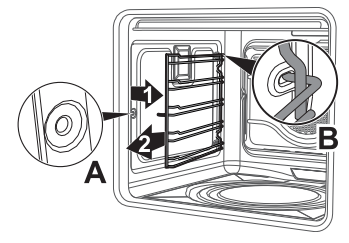
Cleaning the top of the compartment (excluding pyrolytic models)
The appliance is equipped with a tilting grill element that allows for easy cleaning of the upper part of the oven compartment.
- Free the upper heating element by gently lifting it and rotating its retaining latch by 90 degrees.
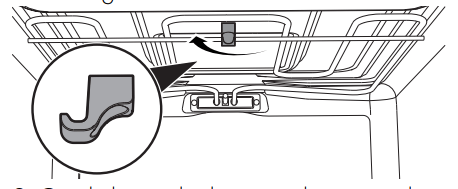
- Gently lower the heating element until it stops
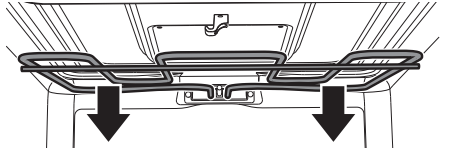
- When you have finished cleaning, place the heating element back in position and turn the retaining latch to lock it in place
Vapor Clean (on some models only)
Preliminary operations
Before starting the Vapor Clean function:
- Completely remove all accessories from inside the oven. The upper guard can be left inside the oven.
- Pour approx. 40 cc of water onto the floor of the oven. Make sure it does not overflow out of the cavity.
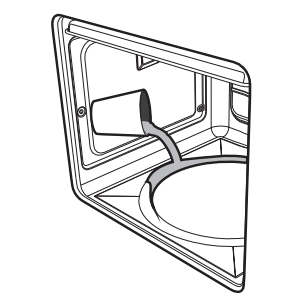
- Spray a water and washing up liquid solution inside the oven using a spray nozzle. Direct the spray against the side walls, upwards, downwards and towards the deflector.
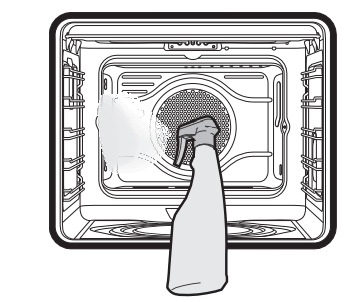
- Close the door.
Vapor Clean setting
- Select the Vapor Clean function from the "special functions” menu.
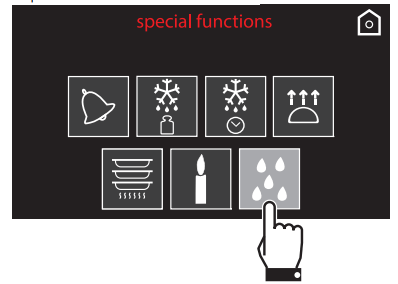
- The duration and temperature of the cleaning cycle will appear on the display.

- Press the symbol
 to confirm. The assisted cleaning cycle will start.
to confirm. The assisted cleaning cycle will start.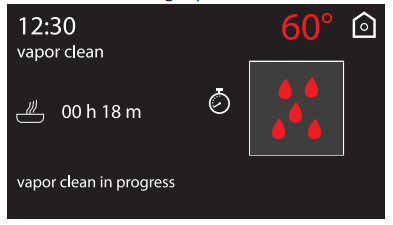
- If the temperature inside the oven is too high, a warning buzzer and message on the display will instruct you to wait for it to cool.
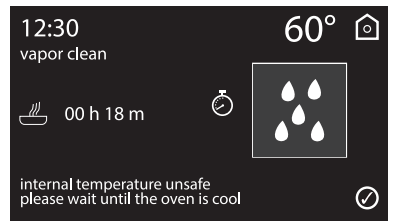
- A buzzer will indicate the end of the Vapor Clean cycle
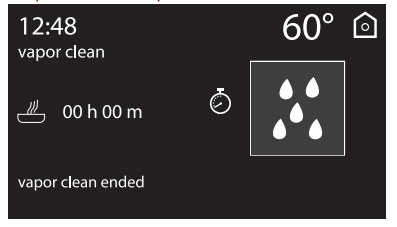
Pyrolytic (on some models only)
The pyrolytic cycle is an automatic high-temperature cleaning procedure that causes dirt to dissolve. Thanks to this process, it is possible to clean the oven cavity very easily.
Improper use
Risk of damage to surfaces
- Remove any food residues or large spills from previous cooking operations from the oven cavity.
- Switch off the burners or hot plates of the cooktop installed above the oven.
Preliminary operations
Before starting the Pyrolytic cycle:
- Clean the internal glass panel following the usual cleaning instructions.
- For very stubborn encrustations spray an oven cleaning product onto the glass (read the warnings on the product); leave for 60 minutes, then rinse and dry the glass using a kitchen roll or a microfibre cloth.
- Completely remove all accessories from inside the oven.
- Remove the rack/tray support frames.
- Close the door.
Pyrolytic function setting
- Select eco pyrolytic or pyrolytic from the “special functions” menu.
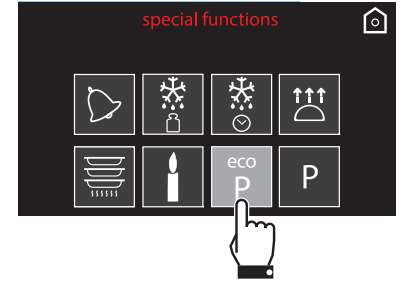
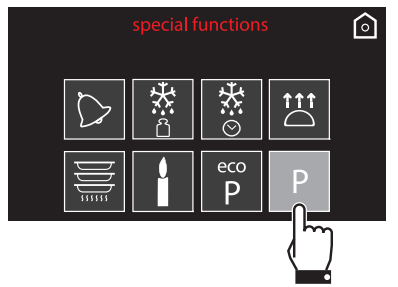
- Enter the required duration of the cleaning cycle (for example 2 hours and minutes: first touch the minutes box, then the numbers 3 and 0).
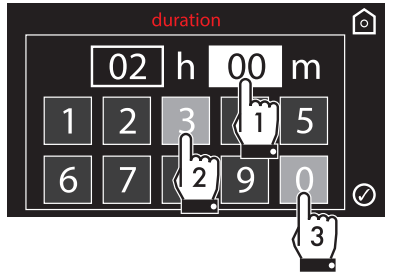
- Press the symbol
 to confirm.
to confirm. - The appliance is ready to start the automatic cleaning cycle. A warning reminds the user to remove any accessories from inside the oven. Press the symbol
 to start pyrolytic cleaning.
to start pyrolytic cleaning.
Pyrolytic cycle
The display shows “cleaning in progress” and the remaining time to indicate that the appliance is carrying out the automatic cleaning cycle. Two minutes after the pyrolytic cycle has started the door is locked (the door lock indicator light  comes on) by a device that prevents the door from being opened.
comes on) by a device that prevents the door from being opened.
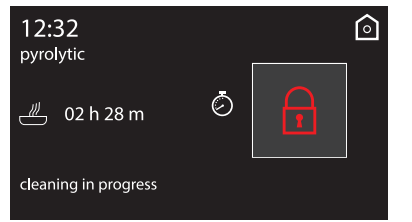
5. At the end of the pyrolytic cycle, the door remains locked as long as the temperature inside the oven returns to safety levels.
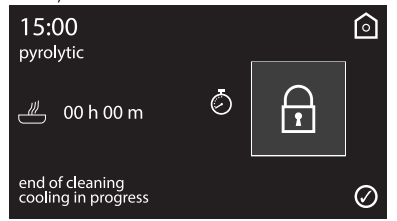
6. After around 20 seconds, the display will indicate that the cooling procedure is in progress.
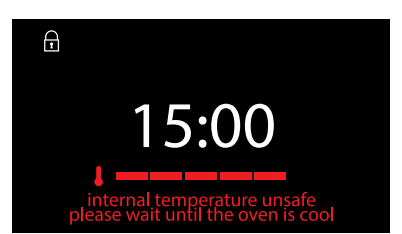
7. Wait for the oven to cool down and collect the residues deposited inside with a damp microfibre cloth.
Setting of programmed pyrolytic cycle
It is possible to program the pyrolytic cycle start time like all other cooking functions.
- After choosing the duration of the pyrolytic function and pressing the symbol
 to confirm, press the symbol
to confirm, press the symbol 
- Press on function delayed.
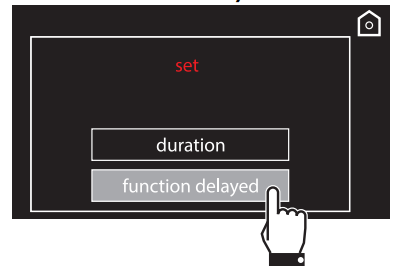
- Enter the time at which you require cooking to end (for example at 7:30 p.m.: first touch the hours box, then the numbers 1 and 9; touch the minutes box, then the numbers 3 and 0).

- Press the symbol
 to confirm.
to confirm.
The appliance waits until the set start time to start the cleaning cycle.
Extraordinary maintenance
Removing and installing the door seal (not on pyrolytic models)
To remove the seal:
- Unhook the clips in the 4 corners then pull the seal outwards.
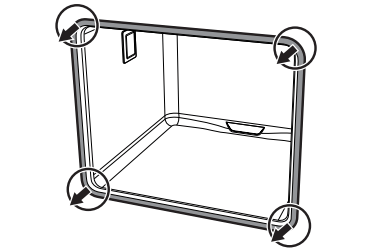
To refit the seal:
- Hook the clips in the 4 corners onto the seal.
Seal maintenance tips
The seal should be soft and elastic.
- To keep the seal clean, use a nonabrasive sponge and wash with lukewarm water.
Replacing the internal light bulb
Live parts
Danger of electrocution
- Unplug the appliance from the power supply.
- Completely remove all accessories from inside the oven.
- Remove the rack/tray support frames.
- Remove the bulb cover using a tool (e.g.a screwdriver).
- Pay attention not to scratch the oven cavity enamel.

- Pay attention not to scratch the oven cavity enamel.
- Slide the lamp out and remove it.

- Do not touch the halogen lamp directly with your fingers, but hold it using an insulating material.
- Replace the lamp with one of the same type (40W).
- Replace the bulb cover. Make sure that the inner shaped part of the glass (A) is facing the door.

- Press the cover completely down so that it attaches perfectly to the bulb support.
What to do if...
The display is completely off:
- Check the mains power supply.
- Check that any circuit breakers upline of the appliance supply line are in the “ON” position.
The appliance does not heat up:
- Check whether it has been set in “demo” mode (for further details see “Settings”).
The controls do not respond:
- Check whether it has been set to “control lock” mode (for further details see “Settings”).
The cooking times are longer than those indicated in the table:
- Check whether it has been set to “ecologic” mode (for further details see “Settings”).
After the (pyrolytic) automatic cleaning cycle it is not possible to select a function:
- Verify whether the door lock has deactivated. If it has not, the oven has a safety device that does not allow functions to be selected while the door lock is active. This is because the temperature inside the oven is still too high to permit any type of cooking.
The display shows “Error 4”:
- The door lock has not properly attached to the door. This might be because the door was accidentally opened during the door lock activation. Switch the oven off and on again, waiting a few minutes before selecting a new cleaning cycle.
If the door is opened during a fan assisted function, the fan stops:
- This is not a fault. It is a normal operation of the appliance, useful when cooking foods in order to avoid excessive heat escaping. When the door is closed, the oven will return to normal operation.
Installation
Electrical connection
Power voltage. Danger of electrocution
- Have the electrical connection performed by authorized persons.
- The appliance must be connected to the earth in compliance with electrical system safety standards.
- Disconnect the mains power supply.
General information
Check the grid characteristics against the data indicated on the plate.
The identification plate bearing the technical data, serial number, and brand name is visibly positioned on the appliance.
Do not remove this plate for any reason. The appliance works at 220-240 V~.
Use a three-pole cable (3 x 1.5 mm2 internal conductors).
Make the ground connection using a wire that is 20 mm longer than the other wires.

Fixed connection
Fit the power line with an omnipolar circuit breaker in compliance with installation regulations.
The circuit breaker should be located near the appliance and in an easily reachable position.
Connection with plug and socket
Make sure that the plug and socket are of the same type.
Avoid using adapters, gang sockets, or extensions as these could cause overheating and a risk of burns.
Cable replacement
Power voltage. Danger of electrocution
- Disconnect the mains power supply.
- Unscrew the rear casing screws and remove the casing in order to access the terminal board.

- Replace the cable.
- Make sure that the cables (for the oven or any cooktop) follow the best route in order to avoid any contact with the appliance.
Positioning
Heavy appliance. Crushing hazard
- Position the appliance into the cabinet cutout with the help of a second person.
Pressure on the open door. Risk of damage to the appliance
- Never use the oven door to lever the appliance into place when fitting.
- Avoid exerting too much pressure on the oven door when open.
Heat production during appliance operation. Risk of fire
- Check that the piece of furniture material is heat resistant.
- Check that the piece of furniture has the required slots.
- Do not install the appliance in a recess that can be closed with a door or in a cupboard.
Position of the power cable

Front panel seal
Glue the seal provided to the rear of the front panel to prevent water or other liquids from leaking in.

Fastening bushings
- Remove the bushing covers inserted on the front of the appliance.

- Mount the appliance into the recess.
- Secure the appliance to the piece of furniture using the screws.

- Cover the bushings using the covers that were previously removed.

Appliance overall dimensions (mm)



Mounting under worktops (mm)

Make sure that the piece of furniture's rear/bottom part has an opening of approx. 60 mm.
Mounting into a column (mm)

Make sure that the piece of furniture's top/rear part has an opening of approx. 35-40 mm deep.

See other models: PM6912WLDX SJF01CREU FQ75XPED LST127-2 FA390X4
